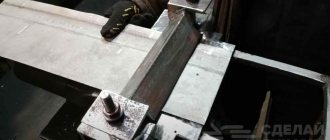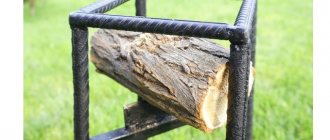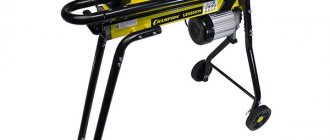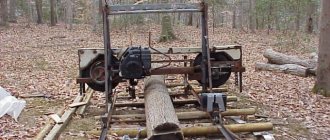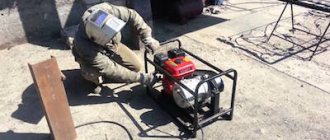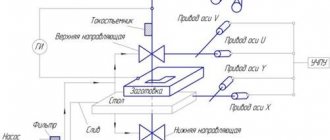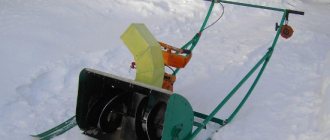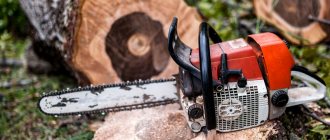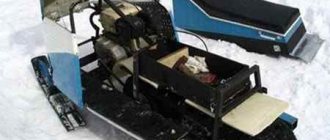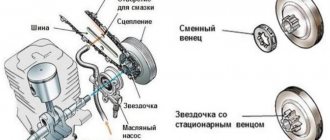A wood sawing machine is designed for cutting raw materials in longitudinal, cross-section, and also at a given angle.
Used in industrial production and at home for cutting chipboard, fiberboard, MDF, and various types of wood. Compact models require the installation of special discs that can be used to cut plastic, soft metals, and stone. There are several types of sawing machines, each of which has its own advantages and disadvantages.
Varieties and characteristics
Based on the type of cutting tool, there are three main types of machines:
- with circular saw (circular);
- with flexible saw;
- with a strip saw.
Based on the location of the cutting tool, machines are classified into vertical and horizontal sawing.
In industrial production and household use, when cutting wood, machines with circular or flexible saws are usually used, and strip saws are widely used in stone processing.
Such machines involve installing a cutter on a special structure or frame. Depending on the type of model, the saw can move straight (for cutting products of low or medium hardness) and curved (for working with particularly durable materials).
You can assemble a wood sawing machine with your own hands at home.
Circular wood saws with a disc are a cost-effective option; with the correct design, they can save up to 50-70% of costs. The main difficulty is the electrical part, which must be done by a professional.
It is also important to design a fire shield. Repairs and maintenance will be much easier when you assembled it yourself. Despite the undeniable advantage in the form of price, homemade machines have some disadvantages.
If the design is incorrect, working on a homemade circular saw for wood can lead to injury and fire. Working with such a tool is potentially dangerous.
A homemade sawing machine has a minimal set of functions and a simple design. This may fail when the volume of work increases. There are no guarantees or quality certificates, so any breakdowns may require significant investments.
Other goat options
The most widely used for sawing single thick logs with chain saws are various sawhorse designs with fixation of the rear part of the log.
kozly-dlya-raspilovki-4
kozly-dlya-raspilovki-2
kozly-dlya-raspilovki-9
These are the ones that are produced most industrially, besides the cruciform ones.
Their designs are so simple that they do not need detailed descriptions; everything can be seen in the photo. Such sawhorses for sawing firewood can be made by any home craftsman who is more or less able to hold a tool in his hands. The main thing here is the ability to balance the dimensions of the support platform with the size and weight of the logs being cut. It may not have a rectangular shape, or even be completely replaced by stops. I liked this goat design for its simplicity and minimalism.
Or this option, designed for very thick, but not long logs:
We recommend: A cutter for metal profiles for drywall - a review of the most popular brands
And finally, we will present a wooden structure that is very successful for home production, which is also guaranteed to ensure that the saw does not jam due to the small width between the saw stops at the cutting site.
In such sawhorses, the log is laid with equal overhang on the sides for stability, and is sawn in the middle. Next, do the same with the resulting pieces.
In all cases, when making a trestle yourself, you choose the height individually, so that, first of all, it is convenient for you.
Dear readers, if you have any questions, please ask them using the form below. We will be glad to communicate with you
Home » Cottage, garden, vegetable garden » Bathhouse
We recommend other articles on the topic
Do-it-yourself chimney in a bathhouse - selection and installation features
Do-it-yourself steam room in a bathhouse, ways of arrangement
Septic tank from tires for a bathhouse - do it yourself
Bathhouse made of foam blocks: projects, reviews from owners
2
Features of making wooden trestles
To work with a one-handed or two-handed saw, a standard-sized machine made of wooden beams is suitable. It turns out to be small, light and durable at the same time. To carry out the assembly, you must perform the following operations:
Prepare a beam 10x10 cm and 1-1.2 m long - for crossbars and legs. The dimensions of the finished product will be enough to cut medium-sized firewood. Proceed with the manufacture and assembly of legs in the amount of 4 pieces. To give greater strength to the connection, cuts are made in each pair of legs. Their depth is maintained at least 1/3 of the thickness of the workpiece, but not more than 1/2. Trying to get a tighter connection, the cuts are made narrower than the width of the workpiece. The timber inserted into the prepared grooves is pushed into place using a hammer. They are fastened to each other, as well as all elements, using 4.5 x 100 mm wood screws or using nails. To prevent lateral displacement of the legs, two wide boards and bars are additionally attached to them horizontally or at an angle. If necessary, “stags” are installed. , their presence will allow you to saw short branches and boards. The finished device is optionally treated with wood stain, and the surfaces are coated with a special protective paint or varnish.
In a similar way, you can make goats from any available material, such as boards or round timber. To make goats, you will need the most accessible tool:
An ordinary hacksaw for wood. A construction angle, but you can do without it. An ordinary pencil with a graphite rod for marking or chalk. A measuring tape. A chisel, a hammer, a screwdriver, a screwdriver. A 4-5 cm paint brush, varnish or paint. A sufficient number of screws , nails.
Circular saw machines
Sawing machines with a circular saw are a large frame with a horizontal working plane. A saw wheel is installed on it, onto which a wooden blank is fed along the bed.
Such models are notable for the fact that they make precise cuts without chips, cracks or peeling. Any design includes the installation of a chip ejector, which simplifies the work. Disc machines, based on power and nature of application, are divided into household ones, with an enlarged tabletop, and stationary ones.
Household or tabletop sawing tools are compact, easy to use and store. The weight of the overall structure is up to 30 kilograms.
To perform work, the bed is installed on a workbench or desktop. They are designed for a moderate amount of work. The maximum cut for longitudinal cutting is 80 mm.
When choosing a wood circular saw for your home, you can pay attention to models that are used for working with large workpieces from 30 to 60 cm.
The average market value of such machines is from 4 to 22 thousand rubles, depending on the configuration and manufacturer.
Machines with an enlarged table top are intermediate sawing equipment, the power of which is superior to household machines, but the productivity is inferior to professional sawing machines.
Such sawing devices have found application in small industrial work and in everyday life. For devices of this power, they are compact; placement and storage do not require much space. Some manufacturers offer folding support legs. Convenient when working with fiberboard, chipboard, MDF, all kinds of boards, especially when a certain curvature path is required. The maximum thickness of material for work is 90 mm.
The average market value is from 4 to 35 thousand rubles, depending on the configuration of auxiliary equipment and the manufacturer.
Stationary (circular saws) – large-sized sawing machines with high power and productivity. Some models of such circular saws are designed for continuous operation for 4-5 hours, others for 8-10 hours, the maximum supply on the market is 16-20 hours. They are used in large-scale production because they have high power and speed of circular rotation, which makes it possible to work with hard types of wood. Maximum cut – 140 mm.
Note! When equipped with a special movable carriage, they are classified as format-cutting machines - the most effective option for cutting or formatting slab, panel and sheet materials. Many models operate exclusively when connected to a three-phase 380V power supply.
Based on the number of working disks, circular machines are divided into single-disk and multi-disk types.
The latter are in turn divided into single-shaft, multi-shaft, and orthogonal. The main difference between the orthogonal type is that there are several vertical and one horizontal disk mounted on a vertical axis, which is convenient for cutting large masses into small ones. Such sawing devices are usually used in stone processing.
| pros | Minuses |
| high productivity, cutting accuracy, no chips, mini-cracks, wood feeding speed can exceed 2 meters per minute, reliability | large amount of wood waste, high cost of cutting tools |
How to make a sawhorse with your own hands for sawing firewood with a two-handed saw
Anyone who has ever sawed a large number of logs with a two-handed “friendship” saw (that’s right, with a small letter. This is not a brand of saw, but a hint of the friendship of two sawmills), knows well how important it is to correctly select the height of the log on the sawhorse. It is believed that the most comfortable height is from 90 to 110 cm. You don’t need to bend your back too much when bending forward, you don’t have to squat, you work comfortably and quickly. After all, working for a long time in an uncomfortable position the next morning will make you like a rusty iron woodcutter - your back and knees will bend with great difficulty.
Important! Basic requirements for goats: stability and strength. Strength is required due to the large weight of the logs and the lateral, alternating forces applied by the sawyers. These efforts will loosen the goats, so the X-shaped racks (“legs” should be supported by a good beam with a side of at least 100 mm.
In order to make sawhorses for sawing wood, we will need:
Beam 100x100 mm, length 1100 mm. It will serve as the basis of the structure. You can also use a flat, dry and not very thick log as a base. Beam 50x50 mm, four sections of 1100 mm each. They will become the “legs” of the goat. Beam 50x50 mm, two pieces of 350 mm each. We will make “horns” from them. Beam 50x50 mm, two pieces of 1100 mm each for tying the “legs”. Self-tapping screws 5x100 mm, about 30 pcs in total. Impregnation “Bioprotection”.
We make cuts on the timber that will serve as the base. We make 12 cuts, two for each groove. We will need 6 grooves, each 25 mm deep, for the “legs” and “horns”.
Important! Try to make cuts slightly narrower than the block. Literally 2 mm. That is, instead of 50 mm, we make cuts of 48 mm. This way the beam will fit into the groove with force, and the entire structure will be stronger.
Using a chisel and hammer, select the grooves along the intended cuts. We forcefully drive the prepared pieces of timber into the grooves: four “legs” and two “horns”. We tighten the screws. Using a hacksaw, we saw off the ends of the timber, which serves as “legs,” at an angle, so that the goats stand firmly and evenly on the ground. The trestle base is assembled.
We make the binding of the “legs”. We attach one end of the beam to the “legs” from the inside, the other – from the outside. Now we are sure that the “legs” will not move apart. We also fix the transverse “leg reinforcements” with self-tapping screws. If the ends of the beam protrude, use a hacksaw to cut them flush with the “legs.” We treat it with bioprotection and you can start cutting firewood.
In addition to the “classic” version of a wooden trestle, you can make metal trestles. This design will be lighter and last longer. They are made from rectangular steel pipe with a side of at least 50 mm. For ease of storage, it is better to secure the crosspieces and trim with bolts rather than welding. When bolted, the structure can be disassembled.
We recommend: Homemade sheet bending machines (sheet benders)
Important! The structure should not be light, otherwise it will be unstable during operation. And make the design according to your height.
The pipe pieces are attached to each other at an angle of 45°. The resulting three crosses are tied with the same pipe horizontally and diagonally for rigidity.
As you can see, sawhorses for sawing wood can be made quite simply with your own hands. Very little material is required for their manufacture, and it is available. Just remember that the goats must be stable, durable and match the height of the sawyer.
Cleaning the chimney with your own hands Do-it-yourself home mini sauna in an apartment How to dry the basement and cellar from moisture How to remove mold from an apartment
With flexible saw
For working with wood, only band sawing machines are used. There are also rope and chain (bar) ones, but they are used for granite, marble and other rocks. The main options for sawing on band saws are: transverse, longitudinal and curved.
Similar woodworking tools are divided into floor and tabletop. Floor-standing ones consist of a one-piece construction; due to their high performance and power, they are used in industry. Tabletop designs are convenient for manual household use. Can be installed on a table or workbench; some models come with a special stand.
Note! The main difference and advantage of a band sawing machine is quiet operation. Therefore, they are well suited for home or garden.
Depending on the model, the machine can be equipped with two or three pulleys for tensioning the cutting belt. One is connected to the engine and is the drive. To preserve the saw in contact with a metal pulley, use a special bandage made of rubber, PVC or cork. Wood sawing machines equipped with a brush and sealed bearings on the pulleys are more reliable.
| pros | Minuses |
| low energy consumption, high output volume, quiet operation, safety, small amount of waste, large cutting height - up to 360 millimeters | maximum wood feed speed is slightly more than a meter per minute, difficult to use with conifers, resin interferes with the tape, cutting accuracy deteriorates, low productivity |
Choosing the right model
Choosing the right wood sawing machine ensures maximum efficiency, productivity, and convenience.
To make the right choice, you need to take into account the types and volumes of future work, all the capabilities and characteristics of the tool:
- power. Wood processing in domestic conditions is possible with a power of 350 watts, in industry - from 2000 watts, in sawmills volumes can reach 15,000 watts;
- depth of cut. The minimum indicators are 40 mm. Production machines can handle thicknesses of 360 mm or more;
- cutting width. This indicator affects the amount of wood waste; it is especially important to reduce losses when working with valuable species;
- Possibility of fine tuning. For accurate cutting, the device must be equipped with a scale with degrees, special rulers, workpiece clamps;
- type. To choose between a circular saw and a band saw, the scale of production, the tasks performed, and the type of wood are determined.
For processing valuable and hard woods, it is better to use belt mechanisms, since they are economical in terms of material. To work with large volumes of material or when increasing speed is necessary, it is better to use disk mechanisms. Do not forget about timely maintenance of any type of wood sawing machines.
How to make your own sawhorses for cutting wood with a chainsaw
Cutting wood is more convenient and much easier with a chainsaw. Especially if the logs were brought to you thick and damp. Cut the firewood quickly, the performance with a chainsaw is completely different.
To cut firewood with a chainsaw, you can use sawhorses assembled according to the traditional pattern. But there is one serious inconvenience - the chain saw will definitely jam when you finish the cut. This happens when a cut is made between the posts (the end of the log protruding beyond the edge of the structure can be easily cut by the saw). To prevent pinching, the log must be turned with the saw down. This is additional and quite hard work, especially when you have to move hefty logs alone.
Craftsmen have developed (and perhaps some of them copied “in Chinese”) designs to avoid clamping the saw chain. And they even patented their designs. Such sawhorses for sawing firewood with a chainsaw can be divided into two types. The first includes metal structures in which the short end of the log is clamped with a chain or toothed grip, and the long free end protrudes far beyond the sawhorse. In these trestles, the supporting “heel” is made so that the log cannot disturb their equilibrium position. This design is reminiscent of imported factory-made goats. Ours just look simpler and the documentation for them (protected by a patent!) is orders of magnitude cheaper.
Another patent-protected design for sawing firewood with a chainsaw is a wooden one:
The advantages of this design include:
The ability to cut logs alone, because there is no need to move them during work. There is no danger of the chain getting caught. The ability to adjust the length of the blocks on which the log is cut. When working on such sawhorses, the blocks are the same length. Sawed off blocks, due to the design features of the sawhorse, roll in the direction opposite to the sawyer. Compact in the folded position. In the utility room near the wall they will take up very little space - the thickness in the folded position is only 12 cm.
